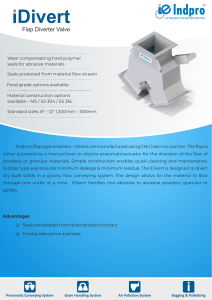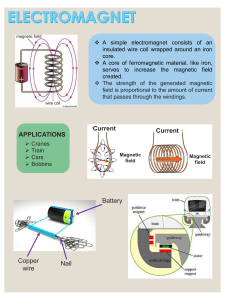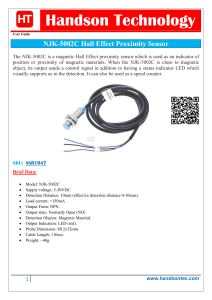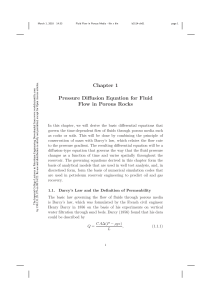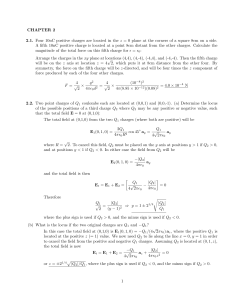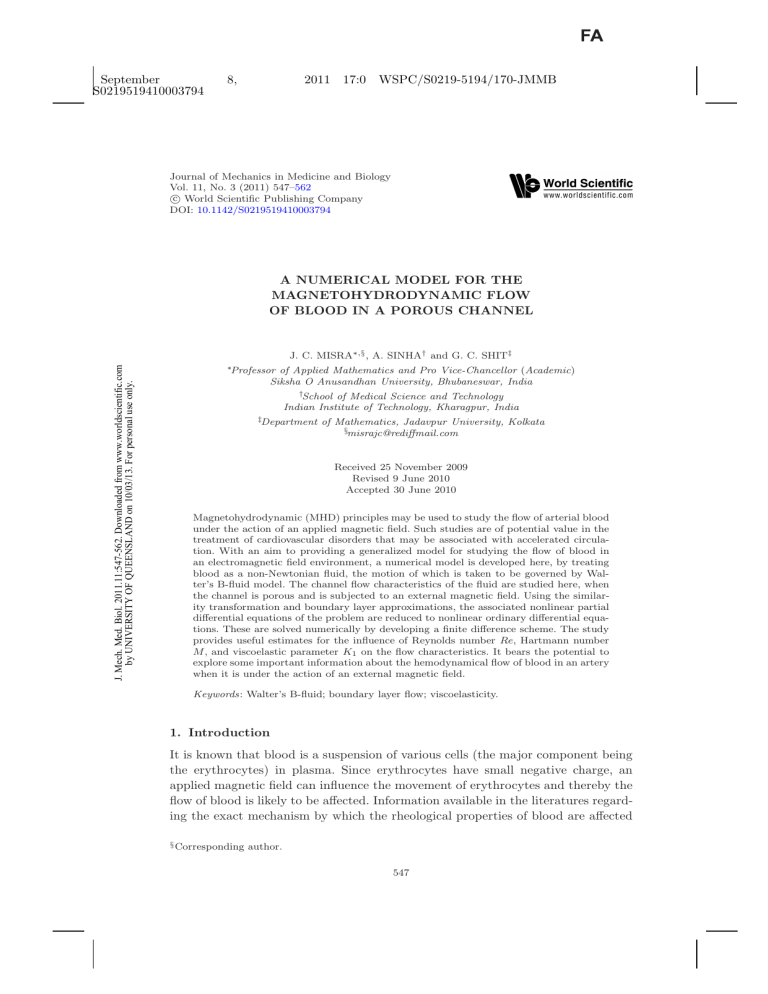
September S0219519410003794 8, 2011 17:0 WSPC/S0219-5194/170-JMMB Journal of Mechanics in Medicine and Biology Vol. 11, No. 3 (2011) 547–562 c World Scientific Publishing Company DOI: 10.1142/S0219519410003794 A NUMERICAL MODEL FOR THE MAGNETOHYDRODYNAMIC FLOW OF BLOOD IN A POROUS CHANNEL J. Mech. Med. Biol. 2011.11:547-562. Downloaded from www.worldscientific.com by UNIVERSITY OF QUEENSLAND on 10/03/13. For personal use only. J. C. MISRA∗,§ , A. SINHA† and G. C. SHIT‡ ∗Professor of Applied Mathematics and Pro Vice-Chancellor (Academic) Siksha O Anusandhan University, Bhubaneswar, India †School of Medical Science and Technology Indian Institute of Technology, Kharagpur, India ‡Department of Mathematics, Jadavpur University, Kolkata §misrajc@rediffmail.com Received 25 November 2009 Revised 9 June 2010 Accepted 30 June 2010 Magnetohydrodynamic (MHD) principles may be used to study the flow of arterial blood under the action of an applied magnetic field. Such studies are of potential value in the treatment of cardiovascular disorders that may be associated with accelerated circulation. With an aim to providing a generalized model for studying the flow of blood in an electromagnetic field environment, a numerical model is developed here, by treating blood as a non-Newtonian fluid, the motion of which is taken to be governed by Walter’s B-fluid model. The channel flow characteristics of the fluid are studied here, when the channel is porous and is subjected to an external magnetic field. Using the similarity transformation and boundary layer approximations, the associated nonlinear partial differential equations of the problem are reduced to nonlinear ordinary differential equations. These are solved numerically by developing a finite difference scheme. The study provides useful estimates for the influence of Reynolds number Re, Hartmann number M , and viscoelastic parameter K1 on the flow characteristics. It bears the potential to explore some important information about the hemodynamical flow of blood in an artery when it is under the action of an external magnetic field. Keywords: Walter’s B-fluid; boundary layer flow; viscoelasticity. 1. Introduction It is known that blood is a suspension of various cells (the major component being the erythrocytes) in plasma. Since erythrocytes have small negative charge, an applied magnetic field can influence the movement of erythrocytes and thereby the flow of blood is likely to be affected. Information available in the literatures regarding the exact mechanism by which the rheological properties of blood are affected § Corresponding author. 547 September S0219519410003794 J. Mech. Med. Biol. 2011.11:547-562. Downloaded from www.worldscientific.com by UNIVERSITY OF QUEENSLAND on 10/03/13. For personal use only. 548 8, 2011 17:0 WSPC/S0219-5194/170-JMMB J. C. Misra, A. Sinha & G. C. Shit by a magnetic field is, however, inadequate. Diamagnetic susceptibility of oxidized hemoglobin and the paramagnetic susceptibility of non-oxidized hemoglobin were studied by Pauling and Coryell.1 Higashi and his associates2 and Yamagishi3 investigated the orientation of erythrocytes in magnetic fields of strengths 8T and 4T respectively. They proclaimed that the erythrocytes orient themselves with their flat side in the direction of the magnetic field. A three-parameter rheological model was used by Kirkovskii et al.4 in order to study the influence of a variable magnetic field on the rheological properties of blood of patients suffering from rheumatoid arthritis. The parameters of the model are related to the hydrodynamic properties of erythrocyte suspension. They observed that out of the three parameters, only one has the capacity to affect the rheological properties of blood to an appreciable extent. Nomenclature η σ ρ ν B0 k0 H (u, v) Re M K1 : : : : : : : : : : : Non-dimensional distance Electrical conductivity Density of blood Kinematic viscosity of blood Strength of the applied magnetic field Coefficient of viscoelasticity Channel width Velocity components along x- and y-directions respectively Reynolds number Magnetic parameter Viscoelastic parameter The study of blood flow under different situations was carried out by several authors. A mathematical model was developed by Misra and Shit5 for studying blood flow through a stenosed arterial segment by taking into account the slip velocity at the wall of the artery. Later on, Misra et al.6 theoretically analyzed the flow of blood obeying Casson’s fluid model through an artery having multiple stenoses. Fung and Sobin7 studied the flow of blood between two endothelial layers, using the sheet model. The mass transfer problem in an alveolar sheet was treated by Tang and Fung.8 McCracken9 used vortex-grid methods to investigate blood flow through the heart valves. The morphometric basis for sheet flow was studied by Sobin et al.10 Peskin11 used numerical techniques to examine the flow of blood in the heart. In recent years, the subject hydromagnetics has attracted the attention of many researchers, due not only to its inherent importance, but also to its multi-fold applications to problems having physiological/geophysical/astrophysical significance. The primary contributors to the magnetohydrodynamic (MHD)12–14 blood flow studied characteristics of blood flow in lungs, where blood can be visualized as flowing between the opposing layers of capillary endothelium, held apart by endothelium-covered “posts” made of special tissue. The capillary endothelium is, September S0219519410003794 8, 2011 17:0 WSPC/S0219-5194/170-JMMB J. Mech. Med. Biol. 2011.11:547-562. Downloaded from www.worldscientific.com by UNIVERSITY OF QUEENSLAND on 10/03/13. For personal use only. Magnetohydrodynamic Flow of Blood 549 in turn, covered by a thin layer (interstitial space) lining the alveoli, which has been treated as a porous medium. The application of magneto-hydrodynamic principles is one method for effecting the flow field in a desired direction by altering the structure of the boundary layer. In fact, the application of MHD principles to biology and medicine has been receiving growing interest of physiologists, medical practitioners, and fluid dynamicists, owing to its importance in biomedical engineering as well as in the treatment of various pathological conditions. Vardanyan15 explored the potential use of MHD principles in prevention and rational therapy of arterial hypertension. He reported that a magnetic field applied in a direction transverse to an artery bears the potential to alter the flow rate of blood. While investigating the effect of a magnetic field on the apparent viscosity of human blood, Haik et al.16,17 observed that blood viscosity is significantly affected by the action of a strong magnetic field. This can be attributed to the variation in the orientation of the erythrocytes due to the action of the magnetic field. Mathematical modeling of blood flow in a channel with stretching walls was performed by Misra et al.18,19 by treating blood as a non-Newtonian viscoelastic fluid. In a separate communication, Misra et al.20 presented a mathematical analysis for the electrical and magnetic fields in osseous tissues induced due to the propagation of torsional waves. The analysis was carried out by paying due attention to the piezoelectric behavior of osseous tissues, in conformity to experimental reports. Misra et al.21,22 investigated the steady flow of an electrically conducting fluid in a parallel plate channel in the presence of a uniform transverse magnetic field. A numerical model was formulated and analyzed by Misra and Shit23 with the motivation of studying the flow of blood through arteries under the action of a transverse magnetic field. They examined the cases of arteries of various sizes and paid due attention to the elastic response of arteries. From the discussion made above, it turns out that the hydrodynamic changes in the flow of blood can take place due to certain external factors. It is known from the study of magnetohydrodynamics that when a transverse magnetic field is applied externally to an electrically conducting fluid, electric currents are induced in the fluid. The interaction between these induced currents and the applied magnetic field produces a body force (Lorentz force) which tends to retard the movement of the fluid. Since blood is an electrically conducting fluid, the motion of blood is expected to be controlled by applying a magnetic field. Thus studies concerned with the effects of a magnetic field on the flow characteristics of blood are of profuse interest to physiologists and clinicians. A theoretical analysis for the flow of blood in ascending and descending aortic segments in the presence of a magnetic field was performed by Kinouchi et al.24 It was observed by Fukuda and Kaibara25 as well as by Stoltz and Lucius26 that, under certain conditions, blood exhibits viscoelastic behavior which may be attributed to the viscoelastic properties of the individual erythrocytes and the internal structures formed by cellular interactions. September S0219519410003794 J. Mech. Med. Biol. 2011.11:547-562. Downloaded from www.worldscientific.com by UNIVERSITY OF QUEENSLAND on 10/03/13. For personal use only. 550 8, 2011 17:0 WSPC/S0219-5194/170-JMMB J. C. Misra, A. Sinha & G. C. Shit The present study is motivated toward a theoretical investigation of the MHD boundary layer flow of blood in the aortic arch. The non-Newtonian character of the fluid is considered to obey Walter’s liquid-B model. This makes the equation of motion highly nonlinear. It is a partial differential equation of order three. The form of the equation being complex, it is not possible to find its exact solution. The method of perturbation has been used, and then a finite difference scheme has been developed to achieve the solution. The influence of various parameters, such as Reynolds number, Hartmann number, and the viscoelastic parameter, has been examined for the cases of both suction and injection. The results are presented in graphical form. The graphs highlight the velocity distribution of blood flowing in the aortic arch under various situations and lead to several important predictions. The results indicate very clearly the threshold value of the magnitude of the magnetic field strength that should be exposed to the human body. The results of the study are expected to be of profound importance to medical surgeons in regulating blood flow during surgery. 2. Mathematical Formulation of the Problem The circulatory system mainly consists of three-dimensional (3D) vessels. However, in some cases, such as in micro-vessels of the lungs, motion of blood is approximately 2D and it can be considered as channel flow. We consider steady flow in a channel having porous boundaries bounded by two thin parallel plates, under the action of a transverse magnetic field. A physical sketch of the geometry is shown in Fig. 1. The x-axis is taken along the centre line of the channel, parallel to the channel surface and y-axis in the transverse direction. The flow is taken to be symmetric about x-axis. The porous walls of the channel can be represented as y = H/2 and y = −H/2 (H being the channel width). The fluid injection/extraction is supposed to take place through the porous walls with velocity V /2. Here, V > 0 corresponds to suction and V < 0 to injection. y B0 B0 y=H/2 y=0 x B0 Fig. 1. Schematic representation of the model geometry. September S0219519410003794 8, 2011 17:0 WSPC/S0219-5194/170-JMMB Magnetohydrodynamic Flow of Blood 551 Let u and v be the velocity components along x-axis and y-axis respectively and B0 be the applied magnetic field. For small magnetic Reynolds number, the induced fields are negligibly small. In the absence of pressure gradient, the equation for MHD boundary layer flow of an incompressible fluid (considered here as Walter’s liquid-B fluid) is ∂u ∂ 2u ∂ 3 u ∂u ∂ 2 u ∂u ∂ 2 u ∂3u ∂u +v = ν 2 − k0 u + v + − u ∂x ∂y ∂y ∂x∂y 2 ∂y 3 ∂x ∂y 2 ∂y ∂x∂y J. Mech. Med. Biol. 2011.11:547-562. Downloaded from www.worldscientific.com by UNIVERSITY OF QUEENSLAND on 10/03/13. For personal use only. −(σB02 /ρ)u, (1) while the continuity equation is ∂u ∂v + = 0, ∂x ∂y (2) in which ρ, ν, B0 , σ, and k0 are respectively the density, kinematic viscosity, strength of the applied magnetic field, electrical conductivity, and the coefficient of viscoelasticity of the fluid. Assuming that the flow is symmetric about the central line y = 0 of the channel, we focus our attention to the flow in the region 0 ≤ y ≤ H2 only. Then the boundary conditions to be taken care of are as follows: ∂u = v = 0 at y = 0 ∂y (3) and u = 0, v = V 2 at y = H . 2 (4) We now introduce the non-dimensional quantities defined by ξ= x y , η = , u = V ξf (η) H H and v = −V f (η). (5) It may be noted that the continuity equation (2) is automatically satisfied. In terms of the non-dimensional variables, Eq. (1) reads f − M f + Re(f f − f 2 ) = K1 [2f f − f f iv − f 2 ] (6) σB 2 H 2 0 in which Re = VνH is the Reynolds number, M = Ha2 = is the square of ν V k0 the Hartman number and K1 = Hν is the viscoelastic parameter. With the use of transformation (5), the boundary conditions (3) and (4) become f (η) = f (η) = 0 at η = 0 (7) and f (η) = 0 and f (η) = − 1 2 at η = 1 . 2 (8) September S0219519410003794 552 8, 2011 17:0 WSPC/S0219-5194/170-JMMB J. C. Misra, A. Sinha & G. C. Shit 3. Perturbation Analysis Considering the viscoelastic parameter K1 to be small, we apply a perturbation expansion approach by writing f = f0 (η) + K1 f1 (η) + K12 f2 (η) + · · · (9) Substituting this into Eq. (6), equating coefficients of like power of K1 and ignoring the quadratic and higher powers of K1 , we obtain f0 − M f0 + Re(f0 f0 − f02 ) = 0 (10) f1 − M f1 + Re(f0 f1 + f1 f0 − 2f0 f1 ) = 2f0 f0 − f0 f0iv − f02 . (11) J. Mech. Med. Biol. 2011.11:547-562. Downloaded from www.worldscientific.com by UNIVERSITY OF QUEENSLAND on 10/03/13. For personal use only. and Using (9) in (7) and (8), the boundary conditions for f0 and f1 become 1 1 −1 , f0 f0 (0) = f0 (0) = 0 and f0 = =0 2 2 2 (12) and f1 (0) = f1 (0) = f1 (1/2) = f1 (1/2) = 0. (13) In the next section, we develop a numerical scheme for solving the nonlinear equations (10) and (11) subject to the boundary conditions (12) and (13). 4. Numerical Methods The system of coupled nonlinear ordinary differential equations (10) and (11) along with the boundary conditions (12) and (13) has been solved numerically by employing a finite difference scheme. We use Newton’s linearization method to linearize the discretized equations. The essential feature of this technique is that it is based on a finite difference scheme, which has better stability characteristics and is quite efficient. It is found to yield sufficiently accurate results. The finite difference technique leads to a system which is tri-diagonal and therefore has speedy convergence. Moreover, it brings about economical memory space to store the coefficients. The computational work has been carried out by taking δη = 0.0125. We have examined that further reduction in δη does not produce any significant change. This ensures the stability of our numerical scheme. The finite difference scheme that we have developed is briefly described below. Substituting f0 = F in Eqs. (10) and (12), we get F − M F + Re(f0 F − F 2 ) = 0 (14) and f0 (0) = F (0) = 0, F (1/2) = 0, f0 (1/2) = −1/2. (15) Similarly, substituting f1 = G in Eqs. (11) and (13), we find G − M G + Re(f0 G + f1 f0 − 2f0 G) = 2f0 f0 − f0 f0iv − f02 (16) September S0219519410003794 8, 2011 17:0 WSPC/S0219-5194/170-JMMB Magnetohydrodynamic Flow of Blood 553 and f1 (0) = G (0) = G(1/2) = f1 (1/2) = 0. (17) Using the central difference scheme for derivatives with respect to η, we can write Ti+1 − Ti−1 + O((δη)2 ) 2δη (18) Ti+1 − 2Ti + Ti−1 + O((δη)2 ), (δη)2 (19) (T )i = and J. Mech. Med. Biol. 2011.11:547-562. Downloaded from www.worldscientific.com by UNIVERSITY OF QUEENSLAND on 10/03/13. For personal use only. (T )i = where T stands for F or G, i is the grid index in η-direction with ηi = i ∗ δη, i = 0, 1, . . . , m and δη is the increment along the η-axis. Newton’s linearization method has been applied to linearize the discretized equations as indicated below. When the values of the dependent variables at the nth iteration are known, the corresponding values of these variables at the next iteration are obtained by using the equation Tin+1 = Tin + (∆Ti )n (20) in which (∆Ti )n represents the error at the nth iteration, i = 0, 1, 2, . . . , n. 5. Results and Discussion The perturbation method and the numerical procedure outlined in the two preceding sections have been employed to solve the differential equations (10) and (11) subject to the boundary conditions (12) and (13). Our endeavor here has been confined to obtaining numerical estimates of the flow parameters in the case of blood flow in the aortic arch. Let us consider that the aortic arch is under the influence of a strong magnetic field of strength B0 = 8T (Tesla). This was the magnetic field strength used by Higashi et al.2 in their experimental study on the orientation of erythrocytes in blood subjected to a strong magnetic field. Further, in finding the estimates, we have taken blood density, ρ = 1050 kg/m3 and electrical conductivity of blood, σ = 0.8 s/m. The numerical results estimated by us have been presented graphically in Figs. 2–9. These figures illustrate the variation of the axial and transverse velocities in the channel flow of blood, with change in Reynolds number Re, Hartmann number M , and viscoelastic parameter K1 in the cases of both suction (Re > 0) and injection (Re < 0). As in Refs. 11, 14 and 27, we have examined different cases taking Re = −10, −5, 5 and 10; K1 = 0.0, 0.005, 0.01 and 0.05, while different magnetic field strengths examined are given by M = 0, 2, 4, 6, 8 and 10 (cf. Ref. 28). Figures 2 and 3 give the distribution of the transverse velocity and the axial velocity respectively for different values of the magnetic parameter M . Figure 2 shows that f decreases with the magnetic parameter M , in the case of suction. This implies that the velocity of blood in the transverse direction can be reduced September S0219519410003794 554 8, 2011 17:0 WSPC/S0219-5194/170-JMMB J. C. Misra, A. Sinha & G. C. Shit 0 M=2.0 M=4.0 M=6.0 M=8.0 -0.1 f -0.2 -0.4 -0.5 0 0.05 0.1 0.15 0.2 0.25 η 0.3 0.35 0.4 0.45 0.5 Fig. 2. Distribution of f for different values of M (when Re = 5.0 and K1 = 0.005). 0 M=2.0 M=4.0 M=6.0 M=8.0 -0.2 -0.4 -0.6 -0.8 f’ J. Mech. Med. Biol. 2011.11:547-562. Downloaded from www.worldscientific.com by UNIVERSITY OF QUEENSLAND on 10/03/13. For personal use only. -0.3 -1 -1.2 -1.4 -1.6 -1.8 -2 0 0.05 0.1 0.15 0.2 0.25 η 0.3 0.35 0.4 0.45 0.5 Fig. 3. Distribution of f for different values of M (Re = 5.0 and K1 = 0.005). September S0219519410003794 8, 2011 17:0 WSPC/S0219-5194/170-JMMB Magnetohydrodynamic Flow of Blood 0 555 Re=-10.0 Re=-5.0 Re=5.0 Re=10.0 -0.1 f -0.2 -0.4 -0.5 0 0.05 0.1 0.15 0.2 0.25 η 0.3 0.35 0.4 0.45 0.5 Fig. 4. Distribution of f for different values of Reynolds number Re (M = 4.0 and K1 = 0.005). 0 Re=-10.0 Re=-5.0 Re=5.0 Re=10.0 -0.5 -1 -1.5 f’ J. Mech. Med. Biol. 2011.11:547-562. Downloaded from www.worldscientific.com by UNIVERSITY OF QUEENSLAND on 10/03/13. For personal use only. -0.3 -2 -2.5 -3 -3.5 0 0.05 0.1 0.15 0.2 0.25 η 0.3 0.35 0.4 0.45 0.5 Fig. 5. Distribution of f for different values of Reynolds number (M = 4.0 and K1 = 0.005). September S0219519410003794 556 8, 2011 17:0 WSPC/S0219-5194/170-JMMB J. C. Misra, A. Sinha & G. C. Shit 0 Re=-10.0 Re=-5.0 Re=5.0 Re=10.0 -0.1 f -0.2 -0.4 -0.5 0 0.05 0.1 0.15 0.2 0.25 η 0.3 0.35 0.4 0.45 0.5 Fig. 6. Distribution of f for different values of Reynolds number (M = 0.0 and K1 = 0.005). 0 Re=-10.0 Re=-5.0 Re=5.0 Re=10.0 -0.5 -1 -1.5 f’ J. Mech. Med. Biol. 2011.11:547-562. Downloaded from www.worldscientific.com by UNIVERSITY OF QUEENSLAND on 10/03/13. For personal use only. -0.3 -2 -2.5 -3 -3.5 0 0.05 0.1 0.15 0.2 0.25 η 0.3 0.35 0.4 0.45 0.5 Fig. 7. Distribution of f for different values of Reynolds number (M = 0.0 and K1 = 0.005). September S0219519410003794 8, 2011 17:0 WSPC/S0219-5194/170-JMMB Magnetohydrodynamic Flow of Blood 0 557 K1=0.0 K1=0.01 K1=0.05 -0.1 f -0.2 -0.4 -0.5 0 0.05 0.1 0.15 0.2 0.25 η 0.3 0.35 0.4 0.45 0.5 Fig. 8. Variation of f with vertical distance for different values of viscoelastic parameter K1 (M = 10.0 and Re = 5.0). 0 -0.2 -0.4 K1=0.0 K1=0.01 K1=0.05 -0.6 -0.8 f’ J. Mech. Med. Biol. 2011.11:547-562. Downloaded from www.worldscientific.com by UNIVERSITY OF QUEENSLAND on 10/03/13. For personal use only. -0.3 -1 -1.2 -1.4 -1.6 -1.8 -2 0 0.05 0.1 0.15 0.2 0.25 η 0.3 0.35 0.4 0.45 0.5 Fig. 9. Variation of f i in the vertical direction for different values of viscoelastic parameter K1 (M = 10.0 and Re = 5.0). September S0219519410003794 2011 17:0 WSPC/S0219-5194/170-JMMB J. C. Misra, A. Sinha & G. C. Shit by increasing the strength of magnetic field. Figure 3 indicates that the axial velocity decreases when the value of magnetic parameter M increases upto the point η = 0.16, beyond which a reverse trend is observed. Thus we can make a conjecture that the (resultant) velocity of blood can be controlled by suitably adjusting (increasing/reducing) the strength of magnetic field. Figures 4 and 5 depict the effect of the magnitude of the Reynolds number on the variations of f and f in the cases of both suction and injection. Figure 4 shows that as in the case of suction, the transverse velocity increases as Reynolds number reduces; however, in the case of injection, it increases with an increase in the value of Reynolds number. During suction, blood velocity in the axial direction increases with a rise in the Reynolds number (cf. Fig. 5) upto a certain height of the channel, beyond which it decreases with an increase in Reynolds number. It may, however, be noted that during injection, there is a reverse trend. Nature of the transverse and axial velocity distributions in the absence of any external magnetic field has been illustrated in Figs. 6 and 7. A comparison between Figs. 4 and 6 reveals that the variation of transverse velocity in the presence/absence of the magnetic field is of similar nature, but the quantitative estimates are different. A similar observation is made for the axial velocity by comparing Figs. 5 and 7. Figures 8 and 9 give the distribution of both the velocity components during suction, corresponding to different values of the viscoelastic parameter, when the system is subjected to a sufficiently strong magnetic field. Figure 8 shows that the transverse velocity is enhanced when the viscoelasticity of blood increases. One 0 -0.2 -0.4 Present study Result of T. Hayat et al. (2006) -0.6 -0.8 f’ J. Mech. Med. Biol. 2011.11:547-562. Downloaded from www.worldscientific.com by UNIVERSITY OF QUEENSLAND on 10/03/13. For personal use only. 558 8, -1 -1.2 -1.4 -1.6 -1.8 -2 0 0.05 0.1 0.15 0.2 0.25 η 0.3 0.35 0.4 0.45 0.5 Fig. 10. Axial velocity distribution for Re = 3.0, M = 6.0 and K1 = 0.005. (Comparison of the present numerical solution with the analytical solution of Hayat et al.) September S0219519410003794 8, 2011 17:0 WSPC/S0219-5194/170-JMMB J. Mech. Med. Biol. 2011.11:547-562. Downloaded from www.worldscientific.com by UNIVERSITY OF QUEENSLAND on 10/03/13. For personal use only. Magnetohydrodynamic Flow of Blood 559 may note from this figure that the transverse velocity decreases in the vertical direction as blood moves from the axis of the vessel towards the wall and it attains its minimum at the wall. Figure 9 indicates that during suction, with an increase in blood viscosity, axial velocity increases upto the point η = 0.3, beyond which it decreases gradually. With an aim to validate our numerical model, we have compared our results for the axial velocity distribution with those reported recently by Hayat et al.29 who carried out a similar study under some simplifying assumptions and obtained analytical solution by using the homotopy analysis method (HAM). We notice that the results of our numerical model are in excellent agreement with those reported by Hayat et al.29 (cf. Fig. 10). 6. Concluding Remarks The magnetohydrodynamic flow of blood has been the concern in this study. The solution to the nonlinear equations that govern the flow is obtained by using a perturbation analysis and by developing a suitable numerical scheme. The analytical solutions for the hydrodynamic case, disregarding inertia effects and fluid viscosity can be obtained as a limiting case by choosing M = 0, Re = 0, and K1 = 0. Magnetic/electromagnetic field therapies have gained sufficient popularity in recent years. They are particularly used to relieve pain and also to accelerate fracture healing in bones. These therapeutic procedures have also been being employed to accelerate the flow of blood and also to treat various health disorders like arthritis in humans. This study confirms that application of magnetic field is also very useful to regulate blood flow, particularly during surgery. Voltage generated due to MHD effect on blood flow in the body may be observed on electrocardiogram (ECG) during cardiac magnetic resonance imaging (MRI). The largest MHD voltage magnitude is observed in the direction perpendicular to the magnetic field lines and the direction of the fluid flow (cf. Refs. 30 and 31). It has been observed that MHD voltages distort the ECG and result in triggering problems for MR image acquisition.32 These voltages are also related to the flow behavior of blood. So an examination of the MHD effect is expected to provide useful information about the blood flow. The spatial distributions of electromagnetic fields in human body by switched magnetic field gradients in MRI have been studied numerically by Bencsik et al.33 The present study is particularly motivated toward examining the flow of blood in the aortic arch due to multi-fold reasons. The aorta is the largest blood vessel in the human body, and the velocity of blood is greatest in the aorta. Also, blood flow through the aortic arch takes place almost perpendicularly to the magnetic field lines. The present study bears the potential to examine the change that takes place in blood velocity, as the magnetic field strength (M ), blood viscoelasticity (measured by K1 ), and Reynolds number (Re) change. September S0219519410003794 J. Mech. Med. Biol. 2011.11:547-562. Downloaded from www.worldscientific.com by UNIVERSITY OF QUEENSLAND on 10/03/13. For personal use only. 560 8, 2011 17:0 WSPC/S0219-5194/170-JMMB J. C. Misra, A. Sinha & G. C. Shit Moreover, although modeling of blood flow in arteries may appear to be more intuitive by considering the tube flow, it is worthwhile to mention that flow in an axisymmetric tube resembles the flow behavior in a channel. This has been the opinion of several previous investigators.34–36 It is with this rationale the problem has been formulated by considering 2D channel flow. The results presented here are applicable to the case of blood vessels in several situations mentioned earlier. Such a consideration is more suitable in the case of vessels having radius ≤ 0.25 mm in the microcirculatory system where the non-Newtonian behavior of blood is very prominent and the erythrocyte concentration is quite high. Owing to the high concentration of erythrocytes, even in the normal physiological state, the vessel geometry in many cases takes a 2D form and the flow of blood well approximates to a channel flow. The investigation reveals very clearly that blood velocity can be controlled by suitably adjusting (increasing/decreasing) the magnetic field strength. The results presented should be of sufficient interest to surgeons who usually want to keep the blood flow at a desired level during the entire surgical procedure. Acknowledgment The authors are thankful to both the reviewers for their kind words of appreciation in respect of the present research as well as for their nice comments on the applicability of the results presented. The original manuscript has been revised on the basis of the reviewers’ suggestions. One of the authors (A. Sinha) is grateful to CSIR, New Delhi for granting SRF to him. References 1. Pauling L, Coryell CD, The magnetic properties and structure of the hemoglobin, oxyhemoglobin and carbonmonoxyhemoglobin, Proc Natl Acad Sci 22:210–216, 1936. 2. Higashi T, Yamagishi A, Takeuchi T, Kawaguchi N, Sagawa S, Onishi S, Date M, Orientation of erythrocytes in a strong static magnetic field, Blood 82:1328, 1993. 3. Yamagishi A, Biological systems in high magnetic field, J Magn Mater 90:43–46, 1990. 4. Kirkovskii VV, Mansurov VA, Mit’kovskaya NP, Mukharskaya Yu A, Influence of a variable magnetic field on the rheological properties of blood in treatment of rheumatoid arteries, J Eng Phys Thermo Phys 76:708–714, 2003. 5. Misra JC, Shit GC, Role of slip-velocity in blood flow through stenosed arteries: A non-Newtonian model, J Mech Med Biol 7:337–353, 2007. 6. Misra JC, Sinha A, Shit GC, Theoretical analysis of blood flow through an arterial segment having multiple stenoses, J Mech Med Biol 8:265–279, 2008. 7. Fung YC, Sobin SS, The theory of sheet flow in lung alveoli, J Appl Physiol 26:472–488, 1969. 8. Tang TA, Fung YC, Solute distribution in the flow in a channel bounded by porous layer, J Appl Mech 42:45–50, 1975. September S0219519410003794 8, 2011 17:0 WSPC/S0219-5194/170-JMMB J. Mech. Med. Biol. 2011.11:547-562. Downloaded from www.worldscientific.com by UNIVERSITY OF QUEENSLAND on 10/03/13. For personal use only. Magnetohydrodynamic Flow of Blood 561 9. McCracken MF, A vortex method for blood flow through heart valves, J Comput Phys 35:183–205, 1980. 10. Sobin SS, Tremer HM, Fung YC, Pulmonary alveolar blood flow, Circ Res 26:397–414, 1970. 11. Peskin CS, Numerical analysis of blood flow in the heart, J Comput Phys 25:220–252, 1977. 12. Mazhbich BI, Transbronchial regional electroplethysmography of the lungs, J Clin Monit 11:225–236, 1995. 13. Pogodin AS, Mazhbich BI, Electroplethysmography evaluation of relative regional lungs blood volume, Bull Exp Biol Med 85:92–94, 1978. 14. Rao PS, Rao JA, Numerical solution of non-steady magnetohydrodynamic flow of blood through a porous channel, J Biomed Eng 10:293–295, 1988. 15. Vardanyan VA, Effect of magnetic field on blood flow, Biofizika 18:491–496, 1973. 16. Haik Y, Pai V, Chen CJ, Apparent viscosity of human blood in a high static magnetic field, J Magn Magn Mater 225:180–186, 2001. 17. Haik Y, Pai V, Chen CJ, Development of magnetic device for cell separation, J Magn Magn Mater 194:254–261, 1999. 18. Misra JC, Shit GC, Rath HJ, Flow and heat transfer of a MHD viscoelastic fluid in a channel with stretching walls: Some applications to haemodynamics, Comput Fluids 37:1–11, 2008. 19. Misra JC, Shit GC, Flow of a biomagnetic viscoelastic fluid in a channel with stretching walls, J Appl Mech 76:061006, 2009. 20. Misra JC, Bera GC, Samanta S, Induced electric and magnetic fields due to wave propagation in a tabular bone, J Math Biol 26:105–120, 1988. 21. Misra JC, Pal B, Gupta AS, Hydromagnetic flow of a second-grade fluid in a channel — Some applications to physiological systems, Math Model Methods Appl Sci 8:1323–1342, 1998. 22. Misra JC, Pal B, Hydromagnetic flow of a viscoelastic fluid in a parallel plate channel with stretching walls, Ind J Math 41:231–247, 1999. 23. Misra JC, Shit GC, Effect of magnetic field on blood flow through an artery: A numerical model, Comput Technol 12:3–16, 2007. 24. Kinouchi Y, Yamaguchi H, Tenforde TS, Theoretical analysis of magnetic field interactions with aortic blood flow, Bioelectromagnetics 17:21–32, 1996. 25. Fukuda E, Kaibara M, Viscoelastic study of aggregation of red blood cells, Biorheology 17:177–182, 1980. 26. Stoltz JF, Lucius M, Viscoelasticity and thixotropy of human blood, Biorheology 18:453–473, 1981. 27. Corieri P, Riethmuller ML, Laser Doppler velocimetry and computer automation to measure low velocities in the pulmonary model, IEEE 226–236, 1989. 28. Midya C, Layek GC, Gupta AS, Mahapatra TR, Magnetohydrodynamic viscous flow separation in a channel with constriction, J Fluids Eng 125:952, 2003. 29. Hayat T, Abbas Z, Sajit M, MHD boundary layer flow of an upper-convected Maxwell fluid in a porous channel, Comput Fluid Dyn 20:229–238, 2006. 30. Togawa T, Okai O, Oshima, M, Observation of blood flow e.m.f. in externally applied strong magnetic field by surface electrodes, Med Biol Eng 5:169–170, 1967. 31. Dimick RN, Hedlund LW, Herfkens RJ, Fram EK, Utz J, Optimizing electrocardiograph electrode placement for cardiac-gated magnetic resonance imaging, Invest Radiol 22:17–22, 1987. 32. Tenforde TS, Magnetically induced electric fields and currents in the circulatory system, Prog Biophys Mol Biol 87:279–288, 2005. September S0219519410003794 562 8, 2011 17:0 WSPC/S0219-5194/170-JMMB J. C. Misra, A. Sinha & G. C. Shit J. Mech. Med. Biol. 2011.11:547-562. Downloaded from www.worldscientific.com by UNIVERSITY OF QUEENSLAND on 10/03/13. For personal use only. 33. Bencsik M, Bowtell R, Bowley R, Electric fields induced in the human body by time-varying magnetic field gradients in MRI: Numerical calculations and correlation analysis, Phys Med Biol 52:2337–2353, 2007. 34. Yin F, Fung YC, Peristaltic waves in circular cylindrical tubes, J Appl Mech 36:679–687, 1969. 35. Shapiro AH, Jaffrin MY, Weinberg SL, Peristaltic pumping with long wavelength at low Reynolds number, J Fluid Mech 37:799–825, 1969. 36. Takabatake S, Ayukawa K, Mori A, Peristaltic pumping in circular cylindrical tubes: A numerical study of fluid transport and its efficiency, J Fluid Mech 193:267–283, 1988.
